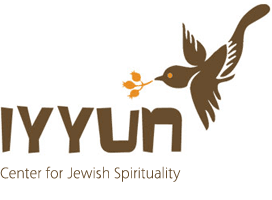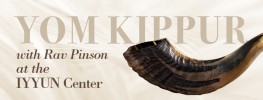The Open Gate
Pesach is not merely the celebration of a past event. It is an open gate to spiritual liberation that manifests every year, in every generation. This powerful day beckons us to release ourselves from our enslavements—any attachment to narrow passions, emotions, instincts, or negative beliefs. It may seem difficult or even impossible to become free of habitual states such as depression or anger. How can we pass through the gate of Pesach into a state of greater freedom?
Stages of Liberation
The science of spiritual liberation reveals three necessary stages: “hachna’ah/submissionâ€, “havdalah/separationâ€, and finally “hamtaka/sweeteningâ€. In order to become free, we must first become aware of our enslavement and taste its bitterness, so that we will ‘submit’ to the call of liberation. Second, we must ‘separate’ and detach ourselves from whatever it is that entraps us. The third stage is a reintegration of our past, where we ‘sweeten’ the bitterness and convert all negativity into holiness. How does this three-stage process relate to the Pesach Seder?
Submission
The stage of “submission†actually begins before the Seder, when we perform the bedikas chametz–the search for leaven. ‘Leaven,’ which causes rising, symbolizes arrogance, ego, the root of spiritual enslavement. Besides meaning searching, the word bedika can also be seen to come from the root boka, ‘to pierce’. We must seek out the arrogance in any of the vessels and/or corners of our lives, acknowledging and accounting for the ways we have become dependent on negative states of being and/or perceiving. In this way, we allow the light of liberation to pierce the darkness of our chametz. When the letter Ches in chametz is pierced, it becomes a letter Hei, – Hei and Ches are similar letters, just in the Hei the left leg is suspended in mid air – and the letters of chametz can then be re-arranged to spell ‘matzah’, referring to the unleavened bread of humility. Before we can attain the level of matzah, however, we have to renounce and destroy our chametz. We don’t eat matzah until we’ve begun the process of the Seder itself.
From Separation to Sweetening
The Seder begins within the stage of “separation†and moves us into the stage of “sweeteningâ€. This process of actualizing freedom is made up of fifteen steps, corresponding to the fifteen well-known simanim, or sections of the Seder – the simanim are attributed to Rashi (Machzor Vitri # 65) The number fifteen is represented by the letters Yud and Hei, which spell a name of Hashem. Just as Hashem brought us out of Egypt in ancient times, so will Hashem bring us through the fifteen stages of the Seder into a new level of freedom.
1) Kadeish
Kadeish means ‘holy, transcendent, or separate’. The act of making Kiddush over wine marks the separation between mundane consciousness of weekdays and the transcendent consciousness of Yom Tov. We initiate our journey by separating ourselves, and decidedly moving away, from our place of comfortable spiritual stagnancy.
2) Urchatz
Once we have tasted transcendence, we can then cleanse ourselves. We wash our hands now, however, we do so without a bracha. The traditional reason for this washing is that we are about to eat a vegetable dipped in salt-water (Pesachim 115a). But in modern times, we are not careful like people were in ancient times to wash our hands before eating vegetables dipped in salt-water. Also, we are used to saying a blessing when we wash for bread following Kiddush, so this washing invites our curiosity. Why is this washing different?
- One reason is simply to prompt the kids at the Seder to ask ‘why’ (Chak Yakkov 463:28).
- A second reason is that this is a remembrance of the era of the Holy Temple, when we did wash in this manner.
- A third reason is that we are already beginning to manifest the manners of a free person. Washing the hands like this is the behavior of royalty who, unlike slaves, have the free time to be meticulously clean.
- On an even deeper level, washing without making a benediction is not a fully positive act. We are still ridding ourselves of subtle traces of negativity. We can’t make a blessing because it’s still a painful experience–our bitterness has not yet been sweetened.
Urchatz has the same letters as rotzeach, ‘murderer’. As we wash, we are ‘murdering’ any negativity that still clings to our hands.
3) Karpas
As we twice-dip a bitter vegetable in salt-water, we become twice as aware of our grief over our enslavement. The salt-water is like the tears that we shed as we continue to regret and release the negativity that has confined our spirit. Again, we don’t say a special blessing over this mitzvah, for we are not yet able to see this stage as a ‘blessing’, but as something we’re compelled to do.
4) Yachatz
As we break the matzah, we realize how fragmented we have become. We hide one of the broken pieces which will be the afikoman, the ‘dessert’. The traditional reason for hiding the afikoman is that it is a remembrance of the pesach offering, which had to be carefully guarded. Spiritually, we are hiding away the fragmented parts of ourselves, and guarding them until the time when we can finally sweeten and reintegrate them.
The matzah that we break is the middle one, the second of the three matzos, which corresponds to the spiritual attribute of gevurah. Becoming aware of our fragmented parts, and yet not reacting, but saving these pieces for a later reintegration, is an act of gevurah, of deep strength and self-mastery.
5) Magid
Slaves don’t have a voice–they don’t dare to speak out regarding their state of exile nor their desire for liberation. We now reach the level of freedom where we are able to speak. When we can articulate our dreams of freedom, which have been buried deep inside, we can begin to understand them and begin to make them into realities.
In Egypt, the power of speech was itself in exile (Zohar 2: 25b). Pharaoh means ‘peh ra’–‘the negative mouth’, destructive speech. During the step of magid, we are transforming ‘peh ra’ into ‘peh-sach–the ‘mouth that speaks’ positive words. This is the true “freedom of speechâ€: to have the inner freedom to express the goodness of life. During this stage of magid, we declare the truth of our inner freedom, and the stage of “sweetening†begins.
6) Rachtzah
At this point, we have risen to a state of consciousness where we are capable of washing our hands with a blessing. The word rachtzah comes from the Aramaic/Talmudic word rachitz, ‘trust’, as in “Bei ana rachitz,†‘In Him do I trust.’ Now that we have articulated our dreams and intentions of becoming free, we can experience true faith. We have freedom to believe. We can trust the ongoing process of liberation. We are no longer merely washing away the negative, as done previously, rather, we are experiencing our own inner purity, and the often taken for granted blessing of being alive.
7-8) Motzi-Matzah
We now make the blessing of hamotzi and eat the matzah. We are ready to internalize this holy humility, or as the Zohar says, the “bread of faithâ€; the “bread of healing†(Zohar 2:41a, 2: 183b). Matzah is perfectly simple bread–like simple and pure faith. We are completely ready to experience healing and wholeness.
9) Maror
After we’ve eaten the ‘bread of faith’, we can turn back and sweeten the bitterness of the past. We take maror, a bitter herb, and dip it into sweet charoses. Our bitterness has a slightly sweet taste now, as we realize that the negativity of the past is precisely what has stimulated us to move forward into deepening freedom. We now understand the positive value of our bitter experiences, and we make a blessing over them.
The word maror has the same numerical value – 446 – as maves, ‘death’ (Shar Hakavonos. Inyon Pesach. Derush 6). Although we cannot deny that we have experienced death of a sort, we are grateful for the redemption this experience is now bringing us, and we see how much more we can achieve in our lives. Now we have faith in the future, and even in the divine light which shines within the darkness of our past.
10) Korech
At this time, we place the ‘bitterness of exile’ into a sandwich, between pieces of the ‘bread of faith’, the bread of freedom. We are unifying affliction and liberation.
Maror represents the yetzer hara, the inclination in the human heart to return to negativity. We place this within the context of the matzah, representing our divine service. Now we can serve and come to life ‘bechol levavcha’ – with both of our ‘hearts’ or inclinations. We are elevating even the destructive inclination, integrating it, and allowing it to serve in our transcendence and ultimate liberation. Death, ego, and slavery are now sweetened–absorbed and transformed into a context of holiness.
11) Shulchan Orech
Now the ‘table’ is prepared. We are spiritually prepared to eat our meal, partaking of physical and spiritual pleasures, for everything is illuminated.
12) Tzafun
Now we can retrieve and internalize the afikoman, the fragmented parts of us that were tzafun –‘hidden’ away at an earlier point. Customarily, a child finds the afikoman and brings it to us (Meiri Pesachim 109a). We are reclaiming our innocent inner child, and we can see the world with joyful purity and wonder.
13) Beirach
Having made made yichud, ‘unification’, within every dimension of our past, we can now see that everything in our life was a bracha, a blessing. We bless, we see blessings, and we ask that we too become sources of blessing.
14) Hallel
The word hallel means both ‘to praise’ and ‘to shine’. As we sing these ecstatic praises, we shine, revealing the light that was hidden in the darkness. This is the brilliant darkness, the night that shines brighter than day.
15) Nirtzah
At last, everything is nirtzah, ‘accepted’–we have arrived. There is nothing more to do or say. This is a non-doing state, rather a state of being.
A state of pure wordless stillness is the world of perfect unity, Divine oneness, the ultimate level of spiritual liberation.
The following forty-nine days of “counting the Omer†have the power to help us fully embody this liberation, this great sweetening of all reality.
(Excerpt from The IYYUN Hagadah. By Rav DovBer Pinson).Ö¼







